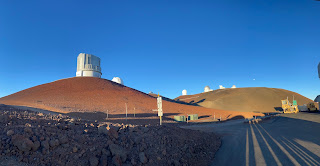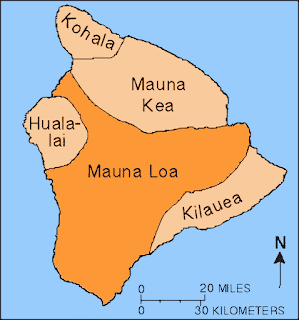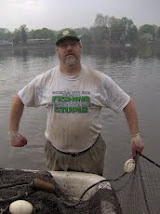There are 5 volcanoes
on the island and two of them, Mauna Loa and Kilauea, are extremely active. Mauna
Kea is considered “active” although it last erupted 4,000 years ago. Hualālai is
another volcano. It last erupted in the early 1800’s and volcanologists think
it is just a matter of time for another eruption. Kohala is the oldest and
considered extinct. It last erupted 60,000 years ago.
Despite all these volcanoes the Big Island is a very popular tourist destination but depending on what you are interested in, and if you have limited time, you must decide between the Kona coast or the Hilo side. They are vastly different.
First, a bit more about
the volcanoes which are all considered mountains.
Kilauea is the youngest volcano
on the Big Island and the most active volcano in the world. Kilauea has been
erupting since 1983.
Here’s a link to a 24/7 livestream of Kilauea caldera:
Mauna Loa is a massive shield volcano that last erupted in December 2022.
 |
| Kailua Kona with Hualalai in background |
Mauna Kea is considered
a spiritual place by native Hawaiians. To read about Mauna Kea:
 |
| Mauna Kea observatories |
Kohala is the oldest volcano
on the Big Island and last erupted 60,000 years ago and is considered extinct. The
mountain extends out from the island like a finger. This area is called the
Kohala coast and some of the best beaches on the island are here.
Shield Volcanoes
Pahoehoe is a smooth billowy
lava while A’a is rough and jagged. I first visited the Big Island in 1988 and photographed the Pahoehoe flow that was covering the town of Kalapana at the time. That picture is featured at the beginning of this entry.
In 2018 the lower rift zone erupted and added a full square mile to the island and the Isaac Hale Beach. Here are two pictures from our recent visit to that area and you can see the difference in A'a lava:
 |
| A'a lava from 2018 eruption |
 |
| new land at Isaac Hale Beach |
To read more about shield
volcanoes:
KONA v HILO
Many of the resorts on the island are on the Kona and Kohala coast and some of the best beaches are located here. Some of the best snorkeling spots are on the Kona coast and it is possible to go swimming at night with Manta Rays.
 |
| Kua Bay, Kohala coast |
Lush rainforests and
waterfalls are on the Hilo side, which is much closer to Volcanoes National
Park. The beaches here are black lava sand and turtles are everywhere.
 |
| swimming with Manta Rays |
We were on both coasts for this last trip, spending time at the Waikoloa Hilton resort and then a vacation rental outside of Hilo where it rained nearly every day.
Richardson Ocean Park, Hilo
Mahalo for reading
Love Janet and greg
© 2025 by Gregory Dunaj



































No comments:
Post a Comment